Georg Lukas, 2023-03-31 17:27
Many years ago, in the summer of 2014, I fell into the rabbit hole of the Samsung NX(300) mirrorless APS-C camera, found out it runs Tizen Linux, analyzed its WiFi connection, got a root shell and looked at adding features.
Next year, Samsung "quickly adapted to market demands" and abandoned the whole NX ecosystem, but I'm still an active user of the NX500 and the NX mini (for infrared photography). A few months ago, I was triggered to find out which respective framework is powering which of the 19(!!!) NX models that Samsung released between 2010 and 2015. The TL;DR results are documented in the Samsung NX model table, and this post contains more than you ever wanted to know, unless you are a Samsung camera engineer.
Hardware Overview
There is a Wikipedia list of all the released NX models that I took as my starting point. The main product line is centered around the NX mount, and the cameras have a "NXnnnn" numbering scheme, with "nnnn" being a number between one and four digits.
In addition, there is the Galaxy NX, which is an Android phone, but also has the NX mount and a DRIM engine DSP. This fascinating half-smartphone half-camera line began in 2012 with the Galaxy Camera and featured a few Android models with zoom lenses and different camera DSPs.
In 2014, Samsung introduced the NX
mini with a 1" sensor and the
"NX-M" lens mount, sharing much of the architecture with the larger NX models.
In 2015, they announced accidentally leaked the NX mini
2,
based on the DRIMeV SoC and running Linux, and even submitted it to the
FCC, but it never materialized on the market
after Samsung "shifted priorities". If you are the janitor in Samsung's R&D
offices, and you know where all the NX mini 2 prototypes are locked up, or if
you were involved in making them, I'd die to get my hands onto one of them!
Most of the NX cameras are built around different generations of the "DRIM engine" image processor, so it's worth looking at that as well.
The Ukrainian company photo-parts has a rather extensive list of NX model boards, even featuring a few well-made PCB photographs. While their page is quirky, the documentation is excellent and matches my findings. They have documented the DRIMe CPU generation for many, but not for all, NX cameras.
Origins of the DRIM engine
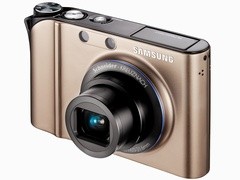
Apparently the first cameras introducing the DRIM engine ("Digital Real Image & Movie Engine") were the NV30/NV40 in 2008. Going through the service manuals of the NV cameras reveals the following:
- NV30 (the Samsung camera, not the Samsung laptop with the same model number): using the Milbeaut MB91686 image processor introduced in 2006
- NV40: also using the MB91686
- NV24: "TWE (MB91043)"
- NV100 (also called TL34HD in some regions): "DRIM II (MB91043)"
There are also some WB* camera models built around Milbeaut SoCs:
- WB200, WB250F, WB30F, WB800F: MB91696 (the SoC has "MB91696B" on it, the service manual claims "MB91696AM / M6M2-J"), firmware strings confirm "M6M2J"
This looks like the DRIM engine is a re-branded Milbeaut MB91686, and the DRIM engine II is a MB91043. Unfortunately, nothing public is known about the latter, and it doesn't look like anybody ever talked about this processor model.
Even more unfortunately, I wasn't able to find a (still working) firmware download for any of those cameras.
Firmware Downloads
Luckily, the firmware situation is better for the NX cameras. To find out more about each of them, I visited the respective Samsung support page and downloaded the latest firmware release. For the Android-based cameras however, firmware images are only available through shady "Samsung fan club" sites.
The first classification was provided by the firmware size, as there were distinct buckets. The first generation, NX5, NX10, and NX11 had (unzipped) sizes of ~15MB, the last generation NX1 and NX500 were beyond 350MB.
Googling for respective NX and "DRIM engine" press releases, PCB photos and other related materials helped identifying the specific generation. Sometimes, there were no press releases mentioning the SoC and I had to resort to PCB photos found online or made by myself or other NX enthusiasts.
Further information was obtained by checking the firmware files with strings and
binwalk, with the details documented
below.
Note: most firmware files contain debug strings and file paths, often
mentioning the account name of the respective developer. Personal names of
Samsung developers are masked out in this blog post to protect the
guilty innocent.
Mirrorless Cameras
DRIMeII: NX10, NX5, NX11, NX100
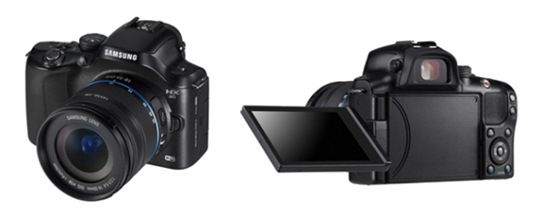
The first NX camera released by Samsung was the NX10, so let's look into its
firmware. The ZIP contains an nx10.bin, and running that through strings
-n 20 still yields some 11K unique entries.
There are no matches for "DRIM", but searching for "version", "revision", and "copyright" yields a few red herrings:
* Powered by [redacted] in DSLR team *
* This version apadpter for NX10 (16MB NOR) *
* Ice Updater v 0.025 (Base on FW Updater) *
* Hermes Firmware Version 0.00.001 (hit Enter for debugger prompt) *
* COPYRIGHT(c) 2008 SYRI *
It's barely possible to find out the details of those names after over a decade, and we still don't know which OS is powering the CPU.
One hint is provided by the source code reference in the binary:
D:\070628_view\NX10_DEV_MAIN\DSLR_PRODUCT\DSP\Project\CSP\..\..\Source\System\CSP\CSP_1.1_Gender\CSP_1.1\uITRON\Include\PCAlarm.h
This seems to be based on a "CSP", and feature "uITRON". The former might be the Samsung Core Software Platform, as identified by the following copyright notice in the firmware file:
Copyright (C) SAMSUNG Electronics Co.,Ltd.
SAMSUNG (R) Core SW Platform 2.0 for CSP 1.1
The latter is µITRON, a Japanese real-time OS specification going back to 1984. So let's assume the first camera generation (everything released in 2010) is powered by µITRON, as NX5, NX10 and NX11 have the same strings in their firmware files.
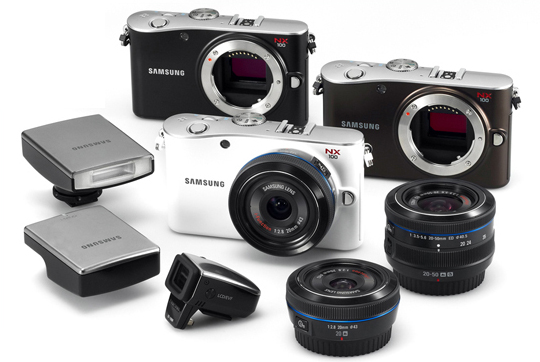
The NX100 is very similar to the above devices, but its firmware is roughly twice the size, given that it has a 32MB NOR flash (according to the bootloader strings). However, there are only 19MB of non-0x00, non-0xff data, and from comparing the extracted strings no significant new modules could be identified.
None of them identify the DRIM engine generation, but the NX10 service manual labels the CPU as "DSP (DRIMeII Pro)", so probably related to but slightly better than NV100's "DRIM II MB91043". Furthermore, all of these models are documented as "DRIM II" by photo-parts, and there is a well-readable PCB shot of the NX100 saying "DRIM engine IIP".
DRIMeIII: NX200, NX20, NX210, NX1000, NX1100
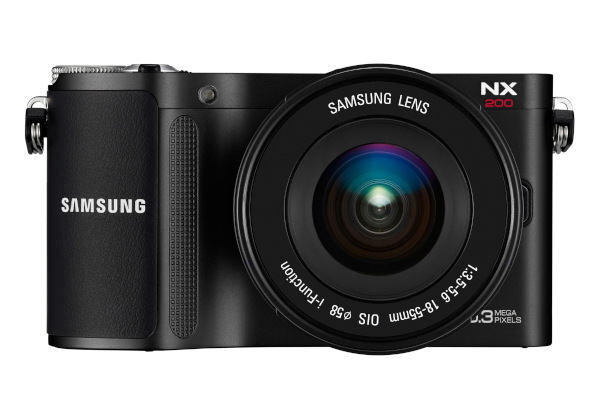
One year later, in 2011, Samsung released the NX200 powered by DRIM (engine) III. It is followed in 2012 by NX20, NX210, and NX1000/NX1100 (the only difference between the last two is a bundled Adobe Lightroom). The NX20 emphasizes professionalism, and the NX1x00 and NX2x0 stand for compact mobility.
The NX200 firmware also makes a significant leap to 77MB uncompressed, and the following models clock in at around 102MB uncompressed.
Each of the firwmare ZIPs contains two files respectively, named after the
model, e.g. nx200.Rom and nx200.bin. Binwalking the Rom doesn't yield
anything of value, except roughly a dozen of artistic collage background
pictures. strings confirms that it is some sort of filesystem not
identified by binwalk (and it contains a classical music compilation, with
tracks titled "01_Flohwalzer.mp3" to "20_Spring.mp3", each roughly a minute
long, sounding like ringtones from the 2000s)! The pictures and music files
can be extracted using PhotoRec.
The bin binwalk yields a few interesting strings though:
8738896 0x855850 Unix path: /opt/windRiver6.6/vxworks-6.6/target/config/comps/src/edrStub.c
...
10172580 0x9B38A4 Copyright string: "Copyright (C) 2011, Arcsoft Inc."
10275754 0x9CCBAA Copyright string: "Copyright (c) 2000-2009 by FotoNation. All rights reserved."
10485554 0x9FFF32 Copyright string: "Copyright Wind River Systems, Inc., 1984-2007"
10495200 0xA024E0 VxWorks WIND kernel version "2.11"
So we have identified the OS as Wind River's VwWorks.
A strings inspection of the bin also gives us "ARM DRIMeIII - ARM926E
(ARM)" and "DRIMeIII H.264/AVC Encoder", confirming the SoC generation, weird
network stuff ("ftp password (pw) (blank = use rsh)"), and even some fancy
ASCII art:
]]]]]]]]]]]]]]]]]]]]]]]]]]]]]]]]]]]]]]]]
]]]]]]]]]]]]]]]]]]]]]]]]]]]]]]]]]]]]]]]
]]]]]]]]]]]]]]]]]]]]]]]]]]]]]]]]]]]]]]
]]]]]]]]]]] ]]]] ]]]]]]]]]] ]] ]]]] (R)
] ]]]]]]]]] ]]]]]] ]]]]]]]] ]] ]]]]
]] ]]]]]]] ]]]]]]]] ]]]]]] ] ]] ]]]]
]]] ]]]]] ] ]]] ] ]]]] ]]] ]]]]]]]]] ]]]] ]] ]]]] ]] ]]]]]
]]]] ]]] ]] ] ]]] ]] ]]]]] ]]]]]] ]] ]]]]]]] ]]]] ]] ]]]]
]]]]] ] ]]]] ]]]]] ]]]]]]]] ]]]] ]] ]]]] ]]]]]]] ]]]]
]]]]]] ]]]]] ]]]]]] ] ]]]]] ]]]] ]] ]]]] ]]]]]]]] ]]]]
]]]]]]] ]]]]] ] ]]]]]] ] ]]] ]]]] ]] ]]]] ]]]] ]]]] ]]]]
]]]]]]]] ]]]]] ]]] ]]]]]]] ] ]]]]]]] ]]]] ]]]] ]]]] ]]]]]
]]]]]]]]]]]]]]]]]]]]]]]]]]]]]]
]]]]]]]]]]]]]]]]]]]]]]]]]]]]] Development System
]]]]]]]]]]]]]]]]]]]]]]]]]]]]
]]]]]]]]]]]]]]]]]]]]]]]]]]]
]]]]]]]]]]]]]]]]]]]]]]]]]] KERNEL:
]]]]]]]]]]]]]]]]]]]]]]]]] Copyright Wind River Systems, Inc., 1984-2007
The 2012 models (NX20, NX210, NX1000, NX1100) contain the same copyright and CPU identification strings after a cursory look, confirming the same info about the third DRIMe generation.
Side note: there is also a compact camera from early 2010, the WB2000/TL350 (EU/US name), also built around the DRIMeIII and also running VxWorks. It looks like it was developed in parallel to the DRIMeII based NX10!
Another camera based on DRIMeIII and VxWorks is the EX2F from 2012.
DRIMeIV, Tizen Linux: NX300(M), NX310, NX2000, NX30
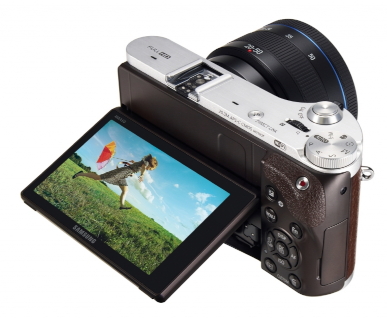
In early 2013, Samsung gave a CES press conference announcing the DRIMe IV based NX300. Linux was not mentioned, but we got a novelty single-lens 3D feature and an AMOLED screen. Samsung also published a design overview of the NX300 evolution.
I've looked into the NX300 root filesystem back in
2014, and the CPU generation was also
confirmed from /proc/cpuinfo:
Hardware : Samsung-DRIMeIV-NX300
The NX310 is just an NX300 with additional bundled gimmicks, sharing the same firmware. The actual successor to the NX300 is the NX2000, featuring a large AMOLED and almost no physical buttons (why would anybody buy a camera without knobs and dials?). It's followed by the NX300M (a variant of the NX300 with a 180° tilting screen), and the NX30 (released 2014, a larger variant with eVF and built-in flash).
All of them have similarly sized and named firmware (nx300.bin), and the
respective OSS downloads feature a TIZEN folder. All are running Linux
kernel 3.5.0. There is a nice description of the firmware file
structure by
Douglas J. Hickok. The bin files begin with SLP\x00, probably for "Samsung
Linux Platform", and thus I documented them as SLP Firmware
Format
and created an SLP firmware
dumper.
Fujitsu M7MU: NX mini, NX3000, NX3300
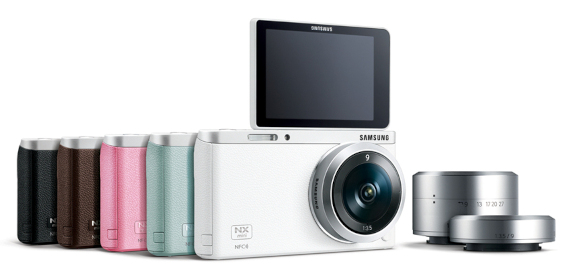
In the first half of 2014, the NX mini was announced. It also features WiFi and NFC, and with its NX-M mount it is one of the smallest digital interchangeable-lens cameras out there! The editor notes reveal that it's based on the "M7MU" DSP, which unfortunately is impossible to google for.
The firmware archive contains a file called DATANXmini.bin (which is not the
SLP format and also a break with the old-school 8.3 filename
convention), and it seems to
use some sort of data compression, as most strings are garbled after 16
bytes or earlier (C:\colomia\Gui^@^@Lib\Sources\Core^@^PAllocator.H, here
using Vim's binary escape notation).
Update: there is now a detailed alanysis of the firmware format and the RELC/LZSS compression algorithm.
There are a few string matches for "M7MU", but nothing that would reveal details about its manufacturer or operating system. The (garbled) copyright strings give a mixed picture, with mentions of:
- ArcSoft
- FotoNation (face detection?)
- InterNiche Technologies (probably for their IPv4 network stack)
- DigitalOptics Corporation (optical systems)
- Jouni Malinen and contributors, with something that looks like a GPL header (this is actually the wpa_supplicant GPL / BSD dual-license):
Copyright (c) 2<80>^@^@5-2011, Jouni Ma^@^@linen <*@**.**>
^@^@and contributors^@^B^@This program ^@^Kf^@^@ree software. Yo!
u ^@q dis^C4e it^AF/^@<9c>m^D^@odify^@^Q
under theA^@ P+ms of^B^MGNU Gene^A^@ral Pub^@<bc> License^D^E versPy 2.
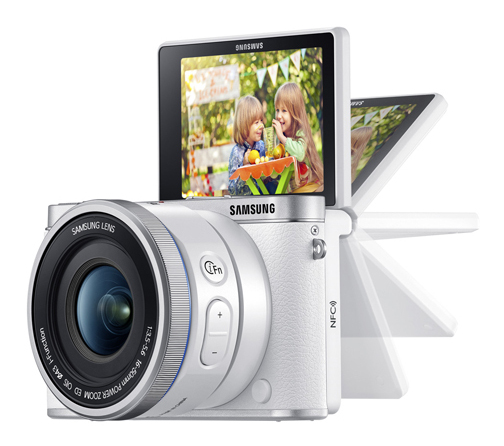
This doesn't give us any hints on what is powering this nice curiosity of ILC. The few PCB photos available on the internet have the CPU covered with a sticker, so no dice there either. All of the above similarly applies to the NX3000, which is running very similar code but has the larger NX mount, and the NX3300, which is a slightly modified NX3000 with more selfie shooting and less Adobe Lightroom.
It took me quite a while of fruitless guessing, until I was able to obtain a (broken) NX3000 and disassemble it, just to remove the CPU sticker.
The sticker revealed that the CPU is actually an "MB86S22A", another Fujitsu Milbeaut Image Processor, with M-7M being the seventh generation (not sure about "MU", but there is "MO" for mobile devices), built around the ARM Cortex-A5MP core!
Github code search reveals that there is actually an M7MU driver in the forked Exynos Linux kernel, and it defines the firmware header structure. Let's hack together a header reader in python real quick now, and run that over the NX mini firmware:
| Header | Value |
|---|---|
| block_size | 0x400 (1024) |
| writer_load_size | 0x4fc00 (326656) |
| write_code_entry | 0x40000400 (1073742848) |
| sdram_param_size | 0x90 (144) |
| nand_param_size | 0xe1 (225) |
| sdram_data | *stripped 144 bytes* |
| nand_data | *stripped 225 bytes* |
| code_size | 0xafee12 (11529746) |
| offset_code | 0x50000 (327680) |
| version1 | "01.10" |
| log | "201501162119" |
| version2 | "GLUAOA2" |
| model | "NXMINI" |
| section_info | 00000007 000000010050e66c 00000002001a5985 0000000300000010 0000000400061d14 00000005003e89d6 0000000600000010 0000000700000010 000000009x 00000000 |
| pdr | "" |
| ddr | 00 b3 3f db 26 02 08 00 d7 31 08 29 01 80 00 7c 8c 07 |
| epcr | 00 00 3c db 00 00 08 30 26 00 f8 38 00 00 00 3c 0c 07 |
That was less than informative. At least it's a good hint for loading the firmware into a decompiler, if anybody gets interested enough.
But why should the Linux kernel have a module to talk to an M7MU? One of the
kernel trees containing that code is called kernel_samsung_exynos5260 and the
Exynos 5260 is the SoC powering the Galaxy K
Zoom. So
the K Zoom does have a regular Exynos SoC running Android, and a second
Milbeaut SoC running the image processing. Let's postpone this Android
hybrid for now.
DRIMeV, Tizen Linux: NX1, NX500, Gear360
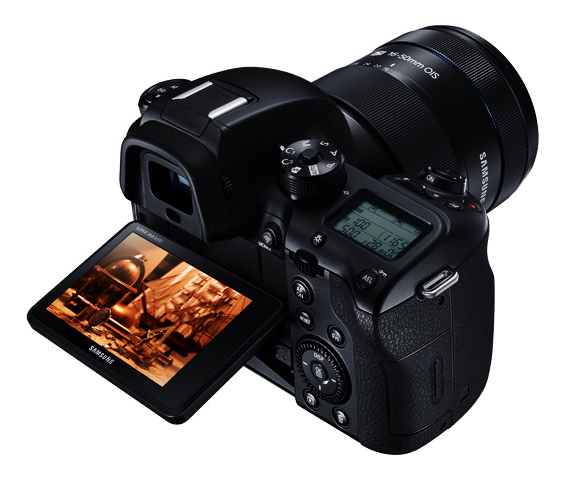
In late 2014, Samsung released the high-end DRIMeV-based NX1, featuring a backside-illuminated 28 MP sensor and 4K H.256 video in addition to all the features of previous NX models. There was also an interview with a very excited Samsung Senior Marketing Manager that contains PCB shots and technical details. Once again, Linux is only mentioned in third-party coverage, e.g. in the EOSHD review.
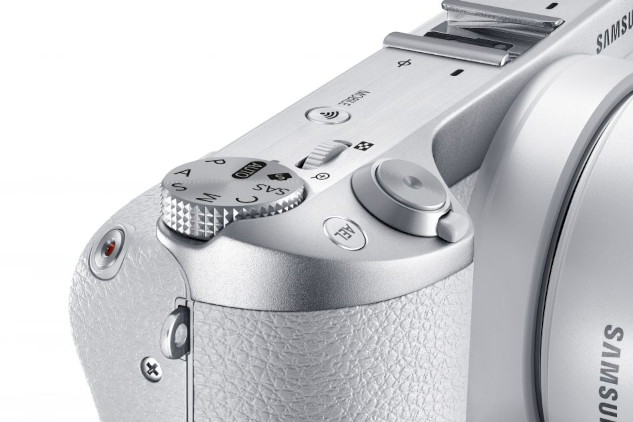
In February 2015, the NX1 was followed by the more compact NX500 based around a slightly reduced DRIMeVs SoC. Apparently, the DRIMeVs also powers the Gear 360 camera, and indeed, there is a teardown with PCB shots confirming that and showing an additional MachXO3 FPGA, but also some firmware reverse-engineering as well as firmware mirroring efforts. The Gear360 is running Tizen 2.2.0 "Magnolia" and requires a companion app for most of its functions.
The NX1 is using the same modified version of the SLP firmware format as the
Gear360. In versions before 1.21, the ext4 partitions were uncompressed,
leading to significantly larger bin file sizes. They still contain Linux
3.5.0 but ext4 is a significant change over the
UBIFS on the DRIMeIV cameras, and
allows in-place modification from a telnet shell.
Android phones with dedicated photo co-processor
Samsung has also experimented with hybrid devices that are neither smartphone nor camera. The first such device seems to be the Galaxy Camera from 2012.
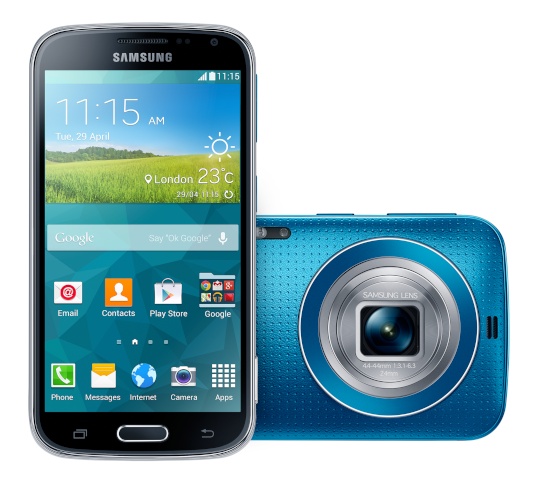
The Android firmware ZIP files (obtained from a Samsung "fan club"
website) contain one or multiple tar.md5 files (which are tar archives with
appended MD5 checksums to be flashed by
Odin).
Galaxy Camera (EK-GC100, EK-GC120)
For the Galaxy Camera EK-GC100, there is a
CODE_GC100XXBLL7_751817_REV00_user_low_ship.tar.md5 in the ZIP, that
contains multiple .img files:
-rw-r--r-- se.infra/se.infra 887040 2012-12-26 12:12 sboot.bin
-rw-r--r-- se.infra/se.infra 768000 2012-12-26 11:41 param.bin
-rw-r--r-- se.infra/se.infra 159744 2012-12-26 12:12 tz.img
-rw-r--r-- se.infra/se.infra 4980992 2012-12-26 12:12 boot.img
-rw-r--r-- se.infra/se.infra 5691648 2012-12-26 12:12 recovery.img
-rw------- se.infra/se.infra 1125697212 2012-12-26 12:11 system.img
None of these look like camera firmware, but system.img is the Android
rootfs (A sparse image convertible with
simg2img to obtain an ext4
image). In the rootfs, /vendor/firmware/ contains a few files, including one
fimc_is_fw.bin with 1.2MB.
The Galaxy Camera Linux source has an Exynos FIMC-IS (Image Subsystem) driver working over I2C, and the firmware itself contains a few interesting strings:
src\FIMCISV15_HWPF\SIRC_SDK\SIRC_Src\ISP_GISP_HQ_ThSc.c
* S5PC220-A5 - Solution F/W *
* since 2010.05.21 for ISP Team *
SIRC-ISP-SDK-R1.02.00
https://svn/svn/SVNRoot/System/Software/tcevb/SDK+FW/branches/Pegasus-2012_01_12-Release
"isp_hardware_version" : "Fimc31"
Furthermore, the firmware bin file seems to start with a typical ARM v7 reset vector table, but other than that it looks like the image processsor is a built-in component of the Exynos4 SoC.
Galaxy S4 Zoom: SM-C1010, SM-C101, SM-C105
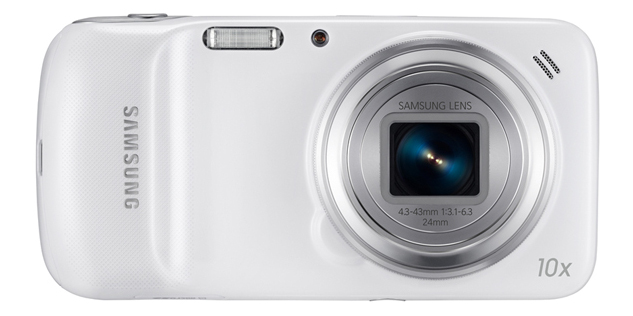
The next Android hybrid released by Samsung was the Galaxy S4
Zoom
(SM-C1010, SM-C101, SM-C105) in 2013. In its CODE_[...].tar.md5
firmware, there is an additional 2MB camera.bin file that contains the
camera processor firmware. Binwalk only reveals a few FotoNation copyright
strings, but strings gives some more interesting
hints, like:
SOFTUNE REALOS/ARM is REALtime OS for ARM.COPYRIGHT(C) FUJITSU MICROELECTRONICS LIMITED 1999
M9MOFujitsuFMSL
AHFD Face Detection Library M9Mo v.1.0.2.6.4
Copyright (c) 2005-2011 by FotoNation. All rights reserved.
LibFE M9Mo v.0.2.0.4
Copyright (c) 2005-2011 by FotoNation. All rights reserved.
FCGK02 Fujitsu M9MO
Softune is an IDE used by Fujitsu and Infineon for embedded processors, featuring the REALOS µITRON real-time OS!
M9MO sounds like a 9th generation Milbeaut image processor, but again there is not much to see without the model number, and it's hard to find good PCB shots without stickers. There is a S4 Zoom disassembly guide featuring quite a few PCB shots, but the top side only shows the Exynos SoC, eMMC flash and an Intel baseband. There are uncovered bottom pics submtted to FCC which are too low-res to identify if there is a dedicated SoC.
As shown above, Samsung has a history of working with Milbeaut and µITRON, so it's probably not a stretch to conclude that this combination powers the S4 Zoom's camera, but it's hard to say if it's a logical core inside the Exynos 4212 or a dedicated chip.
Galaxy NX: EK-GN100, EK-GN120
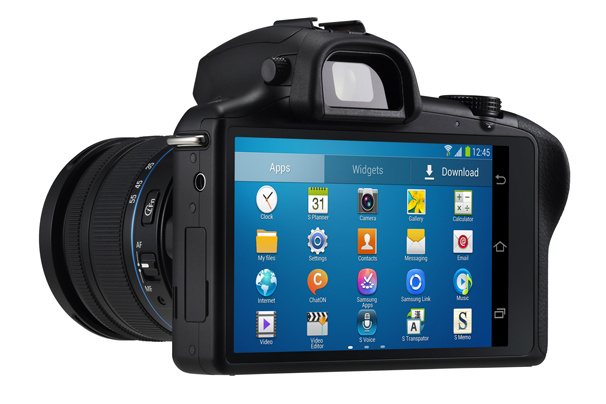
Just one week after the S4 Zoom, still in June 2013, Samsung announced the Galaxy NX (EK-GN100, EK-GN120) with interchangeable lenses, 20.3MP APS-C sensor, and DRIMeIV SoC - specs already known from January's NX300.
But the Galaxy NX is also an Android 4.2 smartphone (even if it lacks microphone and speakers, so technically just a micro-tablet?). How can it be a DRIMeIV Linux device and an Android phone at the same time? The firmware surely will enlighten us!
Similarly to the S4 Zoom, the firmware is a ZIP file containing a
[...]_HOME.tar.md5. One of the files inside it is camera.bin, and this
time it's 77MB! This file now features the SLP\x00 header known from the
NX300:
camera.bin: GALAXYU firmware 0.01 (D20D0LAHB01) with 5 partitions
144 5523488 f68a86 ffffffff vImage
5523632 7356 ad4b0983 7fffffff D4_IPL.bin
5530988 63768 3d31ae89 65ffffff D4_PNLBL.bin
5594756 2051280 b8966d27 543fffff uImage
7646036 71565312 4c5a14bc 4321ffff platform.img
The platform.img file contains a UBIFS root partition, and presumably vImage
is used for upgrading the DRIMeIV firmware, and uImage is the standard kernel
running on the camera SoC. The rootfs is very similar to the NX300 as well,
featuring the same "squeeze/sid" string in /etc/debian_version, even though
it's again Tizen / Samsung Linux Platform. There is a 500KB
/usr/bin/di-galaxyu-app that's probably responsible for camera operation
as well as for talking to the Android CPU. Further reverse engineering is
required to understand what kind of IPC mechanism is used between the cores.
The Galaxy NX got the CES 2014 award for the first fully-connected interchangeable lens camera, but probably not for fully-connecting a SoC running Android-flavored Linux with a SoC running Tizen-flavored Linux on the same board.
Galaxy Camera 2
Shortly after the Galaxy NX, the Galaxy Camera 2 (EK-GC200) was announced and presented at CES 2014.
Very similar to the first Galaxy Camera, it has a 1.2MB
/vendor/firmware/fimc_is_fw.bin file, and also shares most of the strings
with it. Apart from a few changed internal SVN URLs, this seems to be roughly
the same module.
Galaxy K Zoom: SM-C115, SM-C111, SM-C115L
As already identified above, the Galaxy K
Zoom
(SM-C115, SM-C111, SM-C115L), released in June 2014, is using the M7M image
processor. The respective firmware can be found inside the Android rootfs at
/vendor/firmware/RS_M7MU.bin and is 6.2MB large. It also features the same
compression mechanism as the NX mini firmware, making it harder to analyze,
but the M7MU firmware header looks more consistent:
| Header | Value |
|---|---|
| code_size | 0x5dee12 (6155794) |
| offset_code | 0x40000 (262144) |
| version1 | "00.01" |
| log | "201405289234" |
| version2 | "D20FSHE" |
| model | "06DAGCM2" |
Rumors of unreleased models
During (and after) Samsung's involvement in the camera market, there were many rumors of shiny new models that didn't materialize. Here is an attempt to classify the press coverage without any insider knowledge:
Samsung NX-R (concept design, R for retro?), September 2012 - most probably an early name of the NX2000 (the front is very similar, no pictures of the back).
Samsung NX400 / NX400-EVF, July 2014 - looks like the NX400 was renamed to NX500, and an EVF version never materialized.
Samsung NX2 prototype, February 2018 - might be a joke/troll or an engineer having some fun. Three years after closing the camera department, it's hard to imagine that somebody produced a 30MP APS-C sensor out of thin air, added a PCB with a modern SoC to read it out, and created (preliminary) firmware.
Samsung NX Ultra, April 1st 2020, 'nuff said.
Conclusion
In just five years, Samsung released eighteen cameras and one smartphone/camera hybrid under the NX label, plus a few more phones with zoom lenses, built around the Fujitsu Milbeaut SoC as well as multiple generations of Samsung's custom-engineered (or maybe initially licensed from Fujitsu?) DRIM engine.
The number of different platforms and overlapping release cycles is a strong indication that the devices were developed by two or three product teams in parallel, or maybe even independently of each other. This engineering effort could have proven a huge success with amateur and professional photographers, if it hadn't been stopped by Samsung management.
To this day, the Tizen-based NX models remain the best trade-off between picture quality and hackability (in the most positive meaning).
(*) All pictures (C) Samsung marketing material
